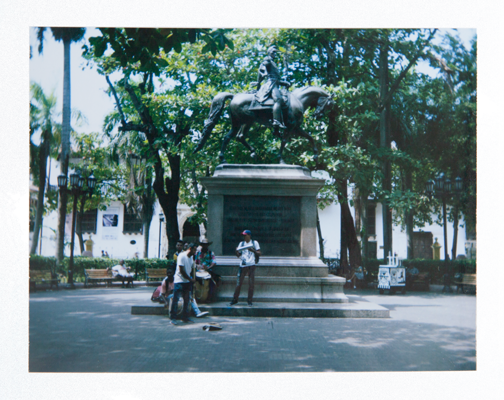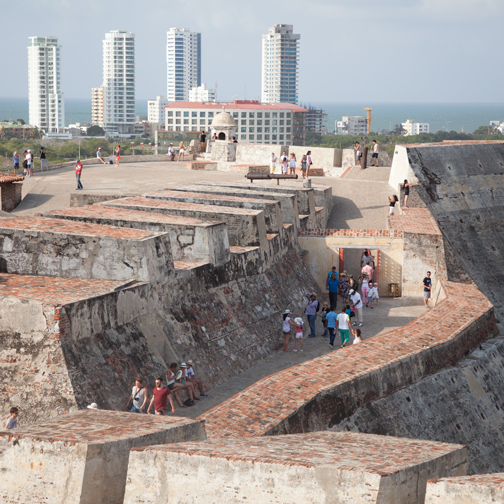Cartagena de Indias is a very hot Caribbean destination in Colombia filled with beautiful architecture and great restaurants. It was founded in the 1500s by the Spanish to protect their access and interests in the Americas.
When it was constructed, the fortified island was divided into an inner city for the wealthier class and an outer city for the artisan classes.
La Matuna and Getsemaní comprise the outer city. They are not as developed as the inner city, but Getsemaní especially has a lot of good restaurants (Cafe Lunático and Oh La La come to mind). The nightlife and open air dining in La Trinidad Square feels authentic and less contrived than some of the more expensive counterparts in the Inner City. The area also has some interesting street art.
Most of the budget hostels are located on Calle de la Media Luna, which is a bit rough around the edges, but the area is undergoing gentrification.
El Centro and San Diego, inside the inner city, have the lion’s share of historical sights, churches, museums, and government buildings. These areas are more expensive and filled with a lot more vendors, hustlers, and street performers. If rapping for tips makes one person money, soon enough there is a whole group of kids doing it. We were approached on two separate occasions by aspiring rappers and both name dropped Harry Potter when trying to describe Barret.
One evening, after several bottles of wine and amazing seafood at El Boliche Cebicheria, we decided to have one last drink in the Santo Domingo Square. Some restaurants were starting to pull their tables in, but there was still a fair amount of people about.
As we relaxing an older guy stopped by with a polaroid around his neck and a metal box with two jump rope-like leads. Grant and the waitress each grabbed a lead while he cranked a handle. Each turn produced a higher and higher voltage until the waitress shrieked and let go.
Because we were shaping up to be the last customers of the night, the electric shock vendor asked 10,000 pesos for the experience. Of course I said no and instead we bargained over the cost of a Polaroid photo. It was a deal after adding a stray dog and the opportunity to shock both of my travel companions.
Bocagrande is a peninsula just outside the walled city that is filled with high-rise developments and casinos. The coastline looks like a watercress sandwich with bite marks and on a sunny day the beach is swarming with families, umbrellas, and hawkers. The most aggressive sells in town are on the Bocagrande Beaches.
The options were limitless: wooden ships, lobster magnets, soda, cigarettes, airbrush tattoos, jet ski rides. Then there were the massage ladies. They carried little footstools and plastic pails filled with massage oils. The lower the sun sank the more aggressive they became and wouldn’t take no for an answer.
One woman squirted aloe onto her hand and started rubbing my neck. No thanks. No. No thank you. I said no thank you!
Ten minutes later another woman squatted in front of me and rubbed the top of my feet. The cool lotion actually did feel good mixed with the fine gritty sand, but I felt that if I said yes, I’d be taken for a ride. No thank you! No. Really- no thank you!
The biggest mistake we made was putting too much confidence in the bottled water. At least that’s the best explanation we came up with. Maybe it was bottled city water or maybe it was over-chlorinated. The only thing for certain is that we were feeling good after our big night out until we opened a new gallon of water. In Grant’s words, it was Superbowel Sunday.
There were a few false starts before we finally left the apartment later that afternoon for the Castillo de San Felipe de Barajas. Its placement just outside the city was strategic as it guarded the bay and the gate entrance to Getsemaní.
It was a steep walk up the fortress in the scorching sun and it was only when we’d made it to the top that we realized we didn’t have a map. Normally I’d head back down, but I was feeling a little weak and dehydrated.
Without any sort of guide, I wasn’t really sure what I was looking at, but there were a lot of dark tunnels to walk through and the texture of the construction material was quite beautiful.
After poking around for two hours, I wasn’t the only one who needed the bathroom. Grant and I looked for the most fortified building we could find and ended up in front of the old hospital. “Even better!”
Unfortunately, the hospital was only a theater with a historical documentary on loop. We walked in on the scene where the Spanish colonists were bayoneting the English; it was the perfect metaphor for my stomach.
About: the food and nightlife in Cartagena
About: Castillo de San Felipe de Barajas
How to get to the Museo del Oro Zenú: Centro, Cra 4, 33-26, Plaza de Bolivar, Cartagena
How to get to El Boliche Cebicheria: San Diego, Calle Cochera del Hobo #38-17, Cartagena











I have Cumbia: Cartagena de Indias.
Vey beautiful photos.
LikeLike
Thanks!
LikeLike